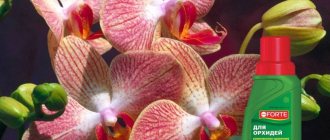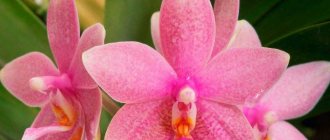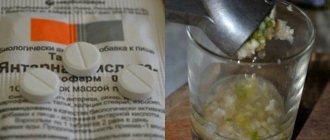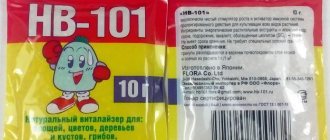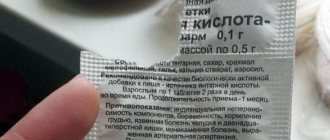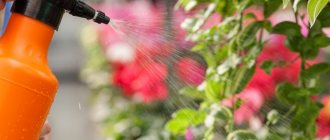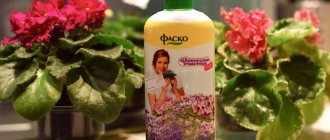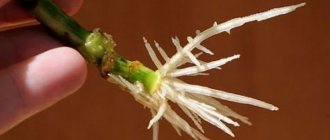An orchid is an original and delicate flower, which is represented by many species. Unfortunately, during the growing process everything does not always go smoothly. It is not uncommon for a plant to become sick or to be attacked by pests. In this case, every gardener should know whether to use foundationazol for orchids or some other drug that will solve the problem.
Many gardeners are surprised why orchids are susceptible to disease, since the flower appeared on the planet not a thousand years ago. Breeders, for their part, did everything possible to breed new specimens that feel great at home.
The reason often lies in improper care and simple mistakes. Often, when gardeners overwater plants, they keep the flower in a room with high temperatures. All this leads to the activation of pathogenic fungi that infect the orchid. Before you start using a fungicide, you need to figure out what problem arose with the flower and what affected it. Otherwise, you can do even more harm.
Abiga Peak
Abiga-Pik is perhaps the most common contact fungicide. It has earned its popularity due to its wide spectrum of action. Thanks to copper oxychloride, which is part of it, the drug copes well with a large number of infections caused by fungi. It does not cause resistance; it can be used in various conditions, including at home.
The drug is produced in the form of a suspension, which is easily diluted in water. It is recommended to spray sick indoor plants with Abiga-Pik fungicide 3-4 times with an interval of 10 days. To prepare the solution you will need 5 ml of product per 1 liter of water. Preventative treatments should be carried out before plants begin to flower.
Review of effective preparations for orchids
Epiphytes have delicate roots and foliage, so not all pesticides are suitable for use. To treat and prevent fungi in plants, products with different compositions are often used. Among the popular drugs, orchid lovers identify several effective ones.
Alirin
A biopesticide based on the bacterium Bacillus subtilis is used for soaking the substrate, roots, and spraying plant foliage. The strain suppresses fungi in the early stages and restores the microflora of the bark. The medicine can be combined with biological agents, but is prohibited with chemistry. Alirin for orchids destroys gray rot and powdery mildew. The drug is available in the form of tablets and powder.
Bordeaux mixture
A complex fungicide is used to eradicate fungal diseases and reduce the acidity of the substrate. The recommended concentration of the solution is 1%, in advanced cases it is increased to 3%. The protection period is 10 days, then the treatment is repeated. The chemical is incompatible with thiram-based pesticides.
Quadris
A systemic drug with a wide spectrum of action copes with common pathogens. The product is used for the treatment and prevention of fungi on flowers. The working solution is quickly absorbed into the vascular system and protects orchids for 14 days. The fungicide is slightly toxic to people and warm-blooded animals.
Copper sulfate
A contact preparation based on copper sulfate is suitable for quickly getting rid of the disease. The chemical retains its properties for 10 days. The chemical loses its effectiveness in hot weather (above +30 C); it is prohibited to use it during flowering or in enclosed spaces.
Mikosan
A biological pesticide based on fungal cells stimulates the formation of enzymes in plants. In orchids, immunity to pathogens increases and stress resistance increases. The drug is effective in the early stages of the disease.
Trichodermin
The biological product is used to prevent root rot and improve the flora of the substrate. The medicine is effective against 60 pathogens and is safe for people, animals and pollinators. Preventive measures in autumn and winter will protect plants from invasion.
Fitosporin
A biological pesticide based on living Bacillus subtilis cells that kills fungal diseases on phalaenopsis. Orchid roots are soaked in the solution, a substrate to prevent the development of diseases. The drug will not help with severe infection.
Pureflower
The preventive fungicide protects against the spread of rot and powdery mildew for 14 days. After 2 hours, the indoor plant produces enzymes that suppress the microflora of the spores. The product is effective in the early stages, but dangerous during mass invasion.
Oksikhom
Another copper-containing fungicide with wide application. In addition to copper hydroxide, the manufacturers included a new agrochemical, oxadixil. Due to this combination, the drug received not only a contact, but also a systemic effect. By acting on pathogens, it simultaneously destroys them and suppresses cell division, which stops the development of spores. The pesticide is a fast-acting substance (the effect on the infection begins in the first 2-3 hours), and it has a long-term preventive effect.
Oxychom is produced in the form of a wettable powder. For spraying indoor plants, a solution of 2 grams of product per 1 liter of water is usually used; to treat red burn of bulbous plants (amaryllis, hippeastrum) you will need 2 times more of the product. Treatment is carried out up to 3 times every 10 days. Since copper hydroxide tends to settle, the finished liquid must be stirred periodically during the procedure.
Reviews from flower growers
Larisa. “I have been using Trichodermin for my orchids for a long time. I use it for prevention. I spray them periodically during the growing season. For all transplants, I always treat the substrate. I place the roots in the solution for about twenty minutes. I let it dry. I prepare different concentrations for soaking and spraying. Convenient to use. I have it in a 200 gram container. I manage without chemicals. A friend advises using it alternately with Alirin.”
Elena. “I try not to use any chemicals on my orchids. They live with us. I use either organic matter or simple medical preparations. Activated carbon, ash, brilliant green, potassium permanganate. But I had to save the roots of the purchased orchid. Fundazol helped. I soaked the roots and treated the soil. Used it twice. No more."
Igor. “I read about the good qualities of the fungicide Maxim. I use it for many bulbous flowers. But also suitable for orchids. When replanting, I always treat the soil. It also improves the soil and preserves microflora. Someone compares it with potassium permanganate. But its protective effect is longer. I’m not complaining yet.”
Vectra
For protective and therapeutic effects, the contact-systemic fungicide Vectra is also used. The pesticide contains dichlorophenyl and triazole. The active ingredients stop the further development of the infection, suppress the sporulation of pathogens and heal the plants. The drug is low-toxic and economical to use.
The agrochemical is supplied for sale in ampoules of 2 and 5 ml of ten percent suspension concentrate. For use at home, dilute 1-1.5 ml per 5 liters of water. Treatment is carried out by spraying 3 times every 10 days.
Biofungicides
Fitosporin
Manufacturers produce the drug in the form of powder, paste or liquid.
It is an environmentally friendly drug, harmless for use at home. It is based on a live culture of Bacillus subtilis 26.
It can be found on sale as powder, paste or liquid.
Any form is a concentrate, which must be prepared as a working solution before use. Its intensity depends on the purpose for which it is used:
- Preventive treatment of planting material – 4 drops of liquid Fitosporin per 200 ml of water. Before planting or transplanting orchids, the roots are placed in the solution for 2 - 3 hours.
- To disinfect the nutrient substrate from fungal pathogens -
5 g of powder per 10 liters of water. Water before planting and while caring for a young plant. If a smaller volume of product is needed, then prepare a solution of 1 g of powder (or 4 drops of liquid) per 1 liter of water.
- For watering at the root of adult plants - 15 drops per 1 liter of water.
- To spray leaves when the first signs of disease appear -
8 – 10 drops per 1 liter of water.
Phytosporin has no restrictions for use, but it will not cope with the advanced form of the disease. Then you will have to resort to the help of chemicals.
Alirin B and Gamair
The preparations contain other strains of the same bacterium as Fitosporin.
in tablets (TAB), liquid or wettable powder. "Gamair" is found in powder, tablets, and as a concentrated suspension. For indoor floriculture, tablets are most often used.
The most effective is the combined use of all three biofungicides:
- For preventive root watering, use a water mixture, for which take 2 tablets of “Alirina B” and “Gamaira” and 1 g of “Fitosporin” powder per 1 liter of water.
- To spray leaves, a less concentrated solution is needed:
- One tablet each of “Alirina B” and “Gamaira”,
- 12 drops “Fitosporin”
- 5 liters of water.
Tip #1: Do not use chlorinated water for the solution.
- To prevent root rot, a liquid mixture of three drugs is used once every 2 to 3 weeks after the main watering.
- Spraying of leaves is carried out once a month.
To better fix the drug on the smooth surface of the leaves, add laundry soap to the solution as an adhesive. You can use purchased products, for example, “Soyuz”, “Record”, “Macho”, etc.
The effectiveness of preventive protection using biofungicides increases significantly if growth stimulants are used together with them:
- "Epin - Extra".
- "Zircon",
- "Ribav - Extra"
- "Gibberyllin."
Mikosan V
"Mikosan" is produced in the form of a concentrate, packaged in sealed bags or bottles.
A unique biological fungicide synthesized from the tinder fungus. It has an effective effect on many pathogens that cause such diseases:
- Various types of root rot,
- powdery mildew,
- Anthracnose,
- Fusarium and other diseases dangerous to orchids.
The systemic effect of the drug is due to the fact that it is absorbed into plant tissue and stimulates the formation of chitinase, chitosanase, and glucanase. These are special phytoenzymes that destroy pathogenic flora . Thus, with the help of Mikosan B, the plant can independently protect itself from fungal and bacterial pathogens.
The positive side of the biofungicide is that, unlike chemicals, it does not kill the beneficial microflora contained in the orchid substrate. In addition to preventive and therapeutic effects, it has an immunological effect. As a result, resistance to diseases and pests increases.
"Mikosan V" is used in the following order:
- For soaking the root system of orchids before planting (transplanting) - 10 ml per 500 ml of water. The roots are kept for 2 - 3 hours.
- Preventive watering of willow orchids 2 weeks after planting (transplantation) - 10 ml per 1 liter of water.
- Treatment of leaves during routine care – 100 ml per 3 liters of water. Spraying is carried out using a sprayer with a fine spray. The first session is planned before flowering begins, each subsequent session after 2 - 3 weeks.
If the infection has gone too far, then Mikosan will not cope with it; it is better to use it for prevention or in the initial stage of the disease.
Vitaros
This contact-systemic fungicide is used only for preventive treatment of seeds, bulbs, tubers and other planting material. Thiram and carboxin, the main substances of the drug, provide growth-regulating and long-lasting, up to six months, protective effects.
The product is available in the form of a concentrated suspension in ampoules of 2 ml and in bottles of 10 to 100 ml. The procedure for soaking the biomaterial takes 2 hours. To prepare the solution, 10 ml per 5 liters of water is required. Thanks to the bright dye included in the pesticide, the processing process is noticeably easier.
The use of Vitaros in the treatment of orchids
Treatment with Vitaros, common to all plants, is not suitable for delicate orchids, since the maximum possible exposure of these flowers in the working solution is no more than 10 minutes. If foci of infection with Alternaria or phyllosticosis are detected, the damaged areas are smeared with a fungicide solution, and the rhizomes are also dealt with when black rot appears. In cases where the infection has spread throughout most of the plant, but the root system can still be saved, the root is cleaned from diseased areas and planted in fresh soil, after having spilled it with a solution of the drug.
What fungicides are used for:
The appearance of an orchid signals problems to a person. The right medicine will help banish the disease. Viral diseases are difficult to cure, so the plant dies. Bacterial spots on the leaves are cut out to healthy tissue, and the wounds are treated with a fungicide.
Root system diseases
Visually, the problem manifests itself on plates that have lost turgor. Blackened or rotten roots cannot cope with the delivery of water, which negatively affects the appearance of the plant. The dead system is cut off and soaked for 30 minutes in the solution:
- copper-containing product;
- Maxim the summer resident;
- Fundazola;
- Topsin.
The flower is left to dry at room temperature for 2 hours, then transplanted into fresh bark. As a preventative measure, flower pots containing the patient are treated with biopesticides (Glyocladin, Baktofit) every 7 days. The pot is placed in a warm, sunny place, but with shade from bright ultraviolet radiation.
Discor
A systemic chemical fungicide is actively used in indoor floriculture. Its active ingredient difenoconazole has a high degree of activity and quickly suppresses the vital processes of pathogens. The drug can be used at any phase of plant development, including during the period of swelling of buds and during flowering. Depending on the infection, treatment is possible by spraying and watering the soil. Also, seed treatment is recommended as a preventive measure and to increase germination.
Discor is produced for home use in the form of an emulsion concentrate, volumes of 2 and 10 ml. For spraying to treat most diseases, 1 ml of product per 5 liters of water is sufficient, to combat gray rot - 2 ml, and for bacterial spots, 2.5 ml per the same volume of liquid is required. The procedure is repeated after two weeks, reducing the concentration of the solution by 2 times.
How to use the drug
All flower growers know that this or that product comes with instructions for use, in which everything is described in detail. However, not everyone knows when and how it is advisable to carry out the treatment.
We are talking about such moments:
- It would be a good idea to treat some parts of the phalaenopsis with fungicides during transplantation.
- Spray the diseased flower.
- When watering, add the solution to the soil to destroy the microorganisms that have settled in it.
Fitosporin-M
The systemic fungicide Fitosporin-M is a preparation of biological origin. The waste products of Bacillus subtilis, which make up the active ingredient of the pesticide, suppress the proliferation of pathogens that cause diseases. The breadth of use of the biofungicide is noted by both gardeners and home gardening enthusiasts. At the same time, it has low toxicity for humans and animals and is absolutely non-phytotoxic. It is possible to spray plants at any time during the growing season, as well as watering to treat the soil, and soaking the seed material and root system of seedlings before planting.
Three forms of the drug are available, differing in the number of bacteria per unit of substance and solubility in water.
- The powder has the largest number of spores and living cells, but it does not dissolve well and requires pre-soaking 1-2 hours before treatment. For prevention, spraying is carried out with a solution of 0.5 teaspoon (1.5 g) per 2 liters of water, for treatment: the same amount of the drug, but per 1 liter of water. For soaking and watering, dilute 2 grams in 1 liter of water.
- The biofungicide is easily diluted in paste form, but it has the lowest bacterial titer. To water the soil, use 15 drops of the substance per 1 liter of water, and 10 for spraying.
- The average between the two previous forms is an aqueous suspension, which also has a gentler effect on plants. The solution for all types of its use will be the same: 10 drops of fungicide per 1 glass of water.
Organic and inorganic fungicides
For orchid owners, the issue of selecting the necessary protective equipment is of particular importance. Fungicides are usually called special chemical substances created to counteract numerous diseases of fungal origin . Translated from Latin - killing mushroom (Fungus - mushroom and Caedo - I kill).
Mother Nature has come up with many diseases for plants. To counteract such a variety of infections, special means are created.
They differ in various parameters, characteristics and purposes:
- By origin: Organic preparations do not contain metals;
- Biological products are in increasing demand. They are created based on the activity and aggressiveness of certain bacteria. They then destroy a number of types of pathogenic fungi;
- Inorganic fungicides for orchids consist of compounds of various chemicals. There may be one element.
- Some drugs retain their properties for a long time in the soil;
- With organic fungicides, this effect is milder and milder. In most cases, no side effects;
- Systemic (intraplant) : Does not immediately affect the foci of the disease;
Systemic fungicide option.
- They reach the affected area and immediately neutralize it;
- Time of action;
- Preventive (protective) . To prevent infection. Their task is to prevent the pathogens from spreading while infection has not yet occurred. Suppress the reproductive organs.
- Treat the tubers and seeds;
Elements included
The composition of inorganic chemicals includes:
- Preparations with copper : Copper sulfate;
- HOM (copper oxychloride);
- Bordeaux mixture;
- Horus.
Fungicide Hom.
- Colloidal sulfur;
Organic biological products consist of:
- From plants (Biorad);
- From mushrooms (Trichodermin);
- From bacteria (Fitosporin, Gaupsin).
Some organic chemicals :
- Carbamates (Tatu, Infinito);
- Dithiocarbamates (Acrobat, Ridomil Gold);
- Morpholines;
- Triazoles (Skor, Topaz);
- Strobilurins (Quadris, Strobi).
Drugs are produced and sold in different states, here is a list of them:
- Aerosols;
- Emulsions;
- Suspensions;
- Dusts;
- Powders;
- Granules;
- Pills.
Types of fungicides:
- Simple;
- Combined: With other fungicides;
- With insecticide;
- With fertilizer.
Fungicides can be simple or combined.
Experienced gardeners prepare tank mixtures for complex treatment of plants. To save time. It is very important to know their compatibility. So that they complement each other.
Methods of application
Specific circumstances and goals determine such methods.
Treatment during transplantation
- Seeds and tubers treated with fungicide provide plants with protection and immunity from diseases. They do this when planting or transplanting;
- This can also be done with dry powders or solutions (soaking).
Spraying infected parts
- To treat plants with fungicide solutions, various sprayers and sprayers are used;
- For orchids, they are very convenient in small volume (up to 1 liter);
- It is important that they disperse the prepared solution well.
Destruction of harmful microorganisms in the soil
- In many situations, soil can be a source and keeper of infections ;
- Options for processing prepared substrates by pouring and soaking are possible;
- Flower growers recommend adding powdered preparations to prepared substrates ;
- This will destroy harmful fungi.
When replanting an orchid, the soil must be disinfected.
Baktofit
The broad-spectrum drug “Baktofit” also belongs to biofungicides. Its active ingredient is Bacillus subtilis strain IPM 215. The bacterium is also called “bacillus hay.” It produces an antibiotic, which becomes destructive for pathogenic fungi. But this requires certain conditions. The air temperature should not exceed +25° C, and the microorganism requires additional nutrition, which can be added in the form of mulch, for example: crushed bark or wood chips. Also, the bacteria does not tolerate chlorine, so it is recommended to let tap water sit before use.
The drug is produced in the form of powder and suspension concentrate. For watering indoor plants, the solution is prepared in the ratio: 3 ml (1 g) of fungicide per 1 liter of water. For spraying against various spots, 1 ml (1 g) per liter of water is used for the working fluid. The procedure is repeated up to three times every 10-12 days.
Main types of plant growth stimulants
Auxins
10 sunny orchids: a review of popular yellow varieties
These are widely known phytohormones that enhance the flow of water and nutrients dissolved in it into plant cells and contribute to their proper redistribution. In the plant, it is produced and accumulated in the cells of the root system, at the apical points of the plant, allowing it to actively grow.
When there is a lack of lighting, treatment with this hormone promotes “stretching” on the darkened side, preventing unnecessary, aesthetically imperfect bends.
The influence of auxins.
Important! Auxins should be used with great caution, observing very precisely the proportions and dosage. The slightest mistake can lead to the opposite effect and even inhibit the development of the orchid
Gibberellins
Gibberellins are plant hormones that regulate plant growth, stem elongation, seed germination, and flowering. This hormone is located in dormant kidneys, therefore, when its concentration is increased artificially, their development is stimulated.
Thus, when an orchid is treated with gibberellin, the development of the flower bud, the formation of buds and flowers is accelerated; they can become larger and display brighter colors. Not only does the flower develop, but the growth of leaves and peduncles also increases.
Along with the active development of the above-ground part, gibberlin provokes the development of cells of the root system, which is important, given that many orchids have a photosynthetic root system and with an increase in the total photosynthetic area, the growth of the plant as a whole is naturally activated
The influence of gibberellins.
Cytokinins
Cytokinins are another type of phytohormone, increasing the concentration of which in the plant:
- stimulates the formation of buds, and, accordingly, the activity of flower formation;
- promotes the opening of stomata, that is, it activates the plant’s respiration process;
- provokes the growth of lateral buds in the presence of dominant apical growth.
They are successfully used for vegetative propagation of plants.
The influence of cytokinins.
Important! Cytokinins require great care when working. Personal protective equipment is required. Be sure to put the drug in a place inaccessible to children!
Be sure to put the drug in a place inaccessible to children!
Agat-25K
Biofungicide "Agat-25K" can be called a drug with multisystem action. It is created on the basis of waste products of bacteria Pseudomonas aureofaciens H16; in addition, the manufacturer added bioactive substances, micro- and macroelements, and active fractions of pine extract to the composition. Thanks to this complex of components, plant immunity is increased, thereby developing resistance to infection, as well as activating the growth of crops and increasing their resistance to adverse factors. The fungicide is safe for both humans and animals, as well as the environment, and has a beneficial effect on the root zone, acting as a fertilizer. The drug combines well with other agrochemicals, and when used together with herbicides, it reduces their negative effects.
In the retail chain, the product is presented in a dark paste form, placed in a syringe with a measuring scale. The solution is prepared in two stages: first, the required amount of biofungicide is diluted in a small amount of water, then the resulting liquid is added to the filled sprinkler. To treat indoor plants, only 3 grams of the drug are required per 10 liters of water. Spraying is carried out 2 times a month.
The table below shows the most common fungal diseases, the houseplants they affect, and the most popular fungicides.
The purpose of using growth stimulants when growing orchids
The issue of using stimulants when growing orchids is a very delicate one.
Some experts do not recommend getting carried away with them, considering artificial stimulation harmful to epiphytes: “You need to handle stimulants carefully. Often gardeners squeeze all the reserves out of a plant, and then are surprised that their orchids quickly age and stop blooming. Epiphytes, in fact, grow and bloom beautifully without any stimulants, if you create the right conditions for them - good light and aeration of the roots, proper watering and moderate mineral supplements.”
A. Davydovskaya, owner of the orchidarium
However, in practice, it is not always possible to create ideal conditions for orchids. Plants stop growing, freeze in the dormant phase, refuse to bloom, and get sick. Therefore, from time to time you have to resort to stimulation.
The use of stimulants is justified in the following cases:
Growth stimulator for orchids: application, reviews. The best growth stimulator for orchids is light. Even if the plants are on the windowsill, it is necessary, if possible, to provide additional lighting for them with a phytolamp
- if, under ideal maintenance conditions, an adult, but not old orchid stops blooming and does not come out of dormancy;
- if the blooming orchid has been stressed and it is necessary to prevent the dropping of flowers;
- if the orchid fades, but does not dry out the peduncle, and it is necessary to give impetus to the development of new flower buds;
- if the orchid has lost its roots and is under intensive care.
Some types of stimulants are also anti-stress agents. It is advisable to use them in cases where the orchid has been subjected to negative external influences - replanting, sudden changes in living conditions, pruning, overdose of fertilizers, etc.
Fusarium orchid blight: signs and treatment features
Fusarium plant blight is a dangerous disease. Its existence became known during the Second World War. Significant damage was caused to the agricultural industry. It turned out that after an infection, the fruits of the plants become inedible. It took many years to find the cause and treatments. Indoor orchids phalaenopsis and calantha, cylagina and paphiopedilum, brassia and cattleya, cymbidium and oncidium, any varieties, ordinary and exhibition specimens can get it. Two types of fungi from the Fusarium family are dangerous - Fusarium solani and Fusarium oxysporum.
Fungicides for orchids list: manufacturers, properties
Orchids, like other plants, are susceptible to infection by various diseases. Diseases often appear due to improper care. Before prescribing treatment, it is important to correctly diagnose and select the right drug. In our article we will talk about what orchids suffer from and what remedies will help heal them.
The exact historical time of orchids is unknown, but it is assumed that they are one of the most ancient plants on Earth. Although, today a huge number of breeding varieties and hybrids have been bred, the plant still belongs to epiphytes.
Specialist consultation
Fungicides for orchids list: manufacturers, properties. In nature, orchids use trees as support without harming them.
Epiphytes are plants that grow on other representatives of the flora, tightly attached to them with roots. At the same time, they consume all nutrients from the air and moisture, and do not harm their “living supports”.
Based on materials from the book
"Rare indoor plants" - authors
S. O. Gerasimov, I. M. Zhuravlev,
The biological characteristics of orchids affect not only the characteristics of cultivation, but also resistance to adverse factors, in particular to pathogens.
Signs of fusarium in orchids
Fusarium orchid blight is easy to recognize. The first signs are weak turgor of leaves and stems and lack of flowering. Soon a symptom such as irregularly shaped spots appears. At first they are yellow in color, then darken. A brown or black border appears, characteristic of infections caused by mold fungi.
The spots turn into thinned depressions. Their area is gradually increasing. They can appear both on the lower stems and on the upper ones, on the outside or inside of the leaf blades. This depends on how exactly the spores entered the plant - through the air or with contaminated soil, during contact with infected garden tools, or in another way.
Vitamin cocktail for orchids
Plants are living organisms just like humans. Naturally, for normal growth they need organic compounds such as vitamins. They contribute to better absorption of microelements, the development of the orchid, its health and, as a result, more confident and lush flowering. Some vitamins help retain moisture in plant tissues, which helps them adapt better and faster to new or changing conditions.
Features of application
Feeding with vitamins is usually similar to “feeding” a person. Vitamins are used during crises, light deficits, exhaustion or illness.
Recovery of an orchid can be quite slow after the use of pesticides; vitamins help neutralize the negative substances of chemical treatments. Vitamins can somehow stimulate systems in a plant, activating certain functions.
Features of treatment of fusarium orchid blight
To date, fusarium has been well studied by scientists. Drugs have been invented to combat it with different principles of action, delicate and potent, bio-based and chemical. They are called fungicides. But in the case of this flower, most of them are not recommended to be used or act with caution. They are only suitable for spraying the above-ground parts.
Mushroom helping orchid
The root system of an orchid may contain microfungi. They help her survive and grow. Absorb nutrients from the soil, improving nutrition of the root system. The relationship is symbiotic, that is, beneficial for both species.
Microbial fungi cannot stop the disease and the proliferation of fusariums, but they increase the flower’s chances of survival even in depleted soil and difficult conditions. When treating the soil with any antifungal drug, their spores may also die. This will be an additional, very strong stress for the plant’s immune system.
It is allowed to spray the above-ground part of an indoor orchid with such popular means as Fitosporin, Fundazol, Baktofit, Hom, Maxim, Sutomai, Daconil, Benlat.
Deserves special attention
Source: mirekzotiki.com
Topudzhin-M paste is applied directly to fungal-affected areas of leaves and stems. The effectiveness and convenience of treating fusarium in indoor orchids with it has been confirmed by many gardeners.
The disadvantage is resistance. With prolonged use, the Fusarium mushroom may develop immunity to it. The main active ingredient is methyl thiophanate.
Treatment of orchid roots
Treating foliage, stems, and infected areas with one of the fungicidal preparations will help slow down the development of fusarium. Fusarium fungi, the causative agents of infection, penetrate the plant cells and the vessels through which the sap circulates.
It is important to stop their spread and this can be done by spraying and applying paste.
If the roots and soil are infected, the situation becomes more complicated.
To cure an orchid, you should check the condition of the roots:
- remove it from the previous soil;
- wash the foliage and roots in water at room temperature;
- remove root shoots and leaves damaged by the fungus, if possible;
- Sprinkle the cut areas with cured activated carbon;
- 3-4 hours after this, carry out spot treatment with a fungicidal preparation;
- transplant into a new flower pot, soil not contaminated with fungus, or into a container with a hydroponic solution.
Fusarium mushrooms can cause irritation on human skin, dermatitis, and an allergic reaction. Therefore, you must use gloves and wash your hands with soap after completing the procedure.
In a situation of severe infection of the root system, new shoots can be sprouted. To do this, orchid stems are placed in a vessel with moss. The flower is periodically sprayed to provide nutrition and maintain vitality. The use of anti-stress medications will speed up the recovery process.
Hydroponics and fusarium
The hydroponics method is considered the most harmonious and safe way to grow flowers. It is universal and relevant in the case of indoor orchids. Despite the benefits, it will not protect against fusarium. These mushrooms are anaerobic. They thrive in both soil and water. Their spores can be carried by wind and raindrops.
The hydroponic method is preferable for other reasons. It will be easier to replace the water in the flowerpot than the soil. It becomes possible to examine the symptoms on the root system and control the situation.
Instructions for use
Proper use of fungicides for orchids will ensure quick relief from the disease. The packaging of each pesticide contains brief instructions and dilution rates for the working solution. The procedures are carried out with gloves and a gauze mask on the face, the liquid is dissolved in a non-food container.
Watering the substrate
Irrigation of the bark with medicine is necessary when replanting plants, for the prevention and suspicion of invasion. Before the event, the orchid is watered and excess moisture is removed from the pan. The pots are placed in the container for 30 minutes, then the substrate is spilled with liquid 5-6 times, and the remains are eliminated.
Spraying
The procedure for plants is carried out in the morning in a non-residential area, on the balcony. A hand-held flower sprayer is used as a sprayer. The foliage and root collar are generously moistened, and the bark is lightly irrigated with the remaining moisture. The orchids are left for 2 hours for the pesticides to dry.
Soaking the roots
Activities are carried out with chemicals with local effects in the maximum safe concentration. The plant is pulled out of the pot, the rotten roots are cut off and left in the solution for 30 minutes. The culture is dried at room temperature for 1.5-2 hours, then planted in a new substrate.
Fungicides are considered mandatory materials that should be in a gardener's first aid kit. Systemic pesticides will quickly destroy an advanced disease, and contact pesticides will help protect the orchid from infection for 4-8 weeks. Biological species not only have bactericidal properties, but also accelerate plant growth and regeneration.
Disease prevention
A well-groomed plant, which has enough nutrients, sunlight, and warmth, will show a greater degree of endurance and will more easily accept treatment. Prevention will save you from worry. Flower growers and orchid fans need to focus on this. Moreover, there are effective preventive methods that provide a 100% guarantee.
On a rainy day
Fusarium spores are most active in cold weather, after rains. If it suddenly gets colder in the summer, the sun is hidden behind thunderclouds, it is advisable to turn on the air conditioning, close the vents and windows. Fusarium mushrooms are a common microorganism in nature. They can live in any country, in any region.
Description of indoor plant
Perennials of the Orchid family have firmly won the hearts of indoor flower lovers. There are thousands of species of orchids in the world, but no more than twenty of them can grow indoors. The plant's homeland is the tropical forests of America and southeast Asia.
Most of them live at the expense of other green fellows located in the neighborhood. Therefore, the roots of orchids are not in the ground, but hang down, receiving nutrition from the bark of trees, the herbaceous layer of soil, and moist air. They are classified as epiphytic plants. It is these varieties that can adapt well to indoor conditions. There are other types of orchids that adorn the rocky cliffs.
The main feature of representatives of epiphytes is a thickened stem, called a pseudotuber.
The ovoid or cylindrical tubers are connected by a thin rhizome. Flowers are located on long peduncles extending from pseudotubers. Their size and color depend on the plant variety. The decorativeness of the flower is in its structure: on the outer side there are two lateral and one upper sepals, on the inner side there is one petal tongue surrounded by lateral ones. This tongue, or delicate lip, of the flower, with its brightness, attracts insects and birds that pollinate orchids.
The lower part of the plant is decorated with dark green leathery leaves, which always look fresh and attractive. This beautiful perennial also requires special care, since it is highly susceptible to unfavorable growing conditions.
How to make an orchid bloom? Or a photo of the results on my flowers
In this review I will talk in detail about Bona Forte orchid fertilizer .
There are about 27 plants in my orchid collection. To tell the truth, I have already lost count, some unfortunately die, some have babies, some I divide into several independent plants.
In my collection you can find Phalaenopsis, various Cambria, Dendrobium, Zygopetalum, Lusidia and Joveara. Links to detailed reviews can be found below.
And, if you are breeding or maintaining indoor plants, then sooner or later the time comes. when they need to be fed, or simply fertilized.
On sale you can find many different products for fertilizing orchids, but I give my preference to Bona Forte fertilizer for orchids .
In this series of fertilizers you can find two series, they differ in the color of the caps and the effect on plants:
1 Series “Beauty” – stimulates flowering (red cap, my review about it),
2 “Health” series – increases plant immunity (purple cap).
➤➤ What microelements affect the duration and density of flowering?
The main components of fertilizers are nitrogen and phosphorus.
The more phosphorus in the fertilizer, the more abundant the flowering will be.
The more nitrogen, the more green mass will grow.
When purchasing any fertilizers for plants, you need to focus on these elements and the result you want to achieve.
If we consider the composition of series No. 1, we can see that Nitrogen is in first place - 4% , in second place is phosphorus - 2.5% .
– Three main macroelements (NPK): nitrogen (N)-4%, phosphorus (P2O5)-2.5%, potassium (K2O)-7% – Main meso-element (Mg): magnesium (MgO)-1.3% – Seven trace elements: Boron, iron, manganese, zinc, copper, molybdenum, cobalt. – Of these, six trace elements are in chelated form: iron, manganese, zinc, copper, molybdenum, cobalt. – Vitamin complex: B1, PP, C. – Growth stimulator: succinic acid.
➤➤ How do I use fertilizer?
In spring, summer and autumn I use fertilizer through watering. I water on average (if we consider phalaenopsis) once every 7-10 days.
In winter - once every 3-4 weeks.
I dilute the fertilizer 1/4 of a cap in 1.5-2 liters of water.
The fertilizer has a bright green color and a not strong, not unpleasant smell.
IMPORTANT. I use fertilizer only on wet roots. Otherwise, the fertilizer may cause burns on the roots.
The manufacturer also recommends using fertilizer to spray the leaves.
Foliar feeding: dilute 1/8 cap (5 ml) in 3 liters of water. Spray the surface of the leaves until completely wet, avoiding getting the solution on the flowers.
I haven't used this method. In general, I try not to spray my orchids, but if the leaves become dirty, wipe them with a damp cloth.
This way there is less chance that water will get into the axils of the leaves and the plant will begin to rot.
➤➤ General information:
➤ The volume of the bottle is 285 ml , it is consumed economically, one bottle lasts for about 3-4 months with regular use.
➤ Shelf life – 4 years , you can use the fertilizer after the expiration date.
➤ Fertilizer price
➤➤ My impression:
About 1 week after using the fertilizer, many flowering “pips” appeared, root activity intensified, young leaves appeared, and the number of buds increased compared to the previous flowering.
I’ll supplement the review with photos of my beauties:
I recommend Bona Forte fertilizer for orchids, I will buy more and recommend it to everyone.
➤➤ Read how I care for my orchids here:
Infectious diseases of orchids
It is very interesting to listen to experts and flower growers about the proper care of orchids. And how to deal with various diseases of these plants. But how do orchids cope with such a horde of diseases in their real habitats? Or are there fewer of them? After all, the conditions are natural.
We ourselves are to a greater extent the culprits of their diseases . Either overfilled or underfilled. It's hot, it's cold.
The main cause of disease is improper care.
The main causes of fungal diseases of orchids:
- Root damage. Like during transplants. So and by various pests;
- Excessive watering and stagnation of moisture;
- Poor room ventilation;
- Oversaturation with nitrogen fertilizers;
- Poor quality substrate. Especially its salinity;
- Unacceptable drop in ground temperature;
- Lack of microelements that provide protective functions of plants.
All parts of the plant can be affected by infections. Regular inspection of plants allows you to quickly detect that not everything is in order with the plant.
Leaves can signal this:
- Darkening;
- Drying and stains;
- Lumps and swellings.
Careful inspection of transparent containers will help determine the condition of the root system. Most often, at home you have to deal with infectious diseases of orchids, which we will discuss below.
Various rots
Gray
Gray rot most often appears on mature plants in the form of brown spots on flowers . Stagnation of cool and humid air most contributes to the development of fungi of this disease. In autumn or spring.
Infection occurs quite quickly: 12-15 hours is enough for nearby other plants to become ill.
Gray rot.
Black rot
The appearance of this disease in orchids is greatly facilitated by pests (bugs, aphids, scale insects). And high humidity and oversaturation of nitrogen in the soil only help its spread.
Black rot.
Anthracnose
Clear small brown spots of a round shape on the leaves ... They indicate that the plant has anthracnose disease:
- Subsequently, the leaves become covered with a black coating or mold with a pinkish tint;
- The affected area is rapidly expanding. If you delay treatment, they can connect and form dents;
- High humidity and stagnant moisture in the leaf axils and cores of pseudobulbs can cause the disease;
- Miltonia, Oncidium, Paphiopedilum, and Phalaenopsis are most often affected.
Powdery mildew
It is characterized by a covering of leaves and buds with a white coating . It’s as if flour was sprinkled on top:
- If measures are not taken, the plant may die;
- Greenhouse conditions (high humidity and high temperature) can most often cause the development of this disease;
- Affects most domestic orchids.
Fusarium
A dangerous disease of orchids with fungi of the genus Fusarium. There are root and stem forms :
- More often, infection can spread from newly acquired plants or seeds;
- It all starts with redness of the roots;
- Then impressions appear. The roots darken and begin to rot.
Fusarium.
Very important! The effectiveness of treatment depends on early detection and timely measures taken. And the correct use of treatments. A diseased plant must be immediately removed from other flowers.
Vitaros: reviews from those who have used the drug
Olga, 40 years old, Volgograd region My husband and I have a large garden plot where we grow potatoes for further sale. To prevent this vegetable crop from suffering from diseases, we have been treating the tubers with Vitaros before planting for the third season. We spray the entire potato crop stored for storage with the same preparation - as a result, our potatoes are not affected by any diseases either during the growth or storage period.
Natalya, 50 years old, Samara region In the garden I grow gladioli for further sale, so it is so important for me that my flowers do not get sick. Before planting, I always soak the tubers of these flowers in Vitaros solution so that the gladioli are not affected in the future by rhizoctonia and fusarium.
At the moment, Vitaros fungicide is considered one of the best drugs that can be used to treat seed material, bulbs, and tubers against most diseases.
Recently also searched:
Possible causes of pests
If your pet has withered, the leaves have lost their juiciness, and buds are not forming, it means that pests may have appeared. The timeliness and method of treating the flower depends on how quickly the type of parasite is determined. The main reasons for their appearance:
- You can buy an already infected plant. Therefore, it is necessary to very carefully examine the entire surface of the leaves and their axils. If you doubt the health of the flower, it is better to refuse this purchase.
ATTENTION! A healthy plant should have: smooth, juicy green leaves, a clean center of the plant with a young leaf sticking out of it, elastic and hard roots, including aerial ones, gray or green in color, flowers and buds, if any, elastic and without foreign stains.
- Working with poor-quality soil or untreated tools. When handling any plant, use only disinfected tools. The soil should not be taken from a personal plot, but from specialized stores, since such a substrate undergoes special treatment.
- Wrong location of the plant in the apartment. Never place orchids outdoors. Pests are just waiting for this.
- Infected plants standing nearby. Flower pots should not be placed closer than 30 cm from each other. In this case, there is a risk of transferring infection from flower to flower, as pests move in search of new food sources. If living creatures attacked several orchids at once, then, unfortunately, the collection cannot be saved from mass infection.
How to identify a pest?
This can be difficult to do due to the fact that the insects themselves are very small and skillfully hide in the soil or leaves. But there are two simple ways to detect parasites:
- In the evening, place a piece of cucumber, carrot, apple or potato next to the pot. In the morning you will be able to see traces of pests or the pests themselves on the left vegetables or fruits.
- Immerse the flower pot in a container with settled warm water. After 2-3 minutes, insects will begin to appear on the surface of the water.
Disease or parasite damage?
Inexperienced gardeners cannot always understand the reason for the death of a plant. Below is a table with possible problems and the reasons for their occurrence. With its help, you will understand whether the flower is sick or is being eaten by parasites:
| Possible problem | The reason for its occurrence |
| White or yellow spots on leaves | Rot, powdery mildew or pests |
| Sticky white coating on leaves | Powdery mildew, aphids, bacterial spot |
| Leaves affected by black spots | Spider mites (improper watering in the cold season), rot |
| Leaves wither | Aphids, mites, bacterial spot |
| Leaves are soft, wrinkled, sometimes rotten | Parasites, bacterial spot, fusarium rot |
| Blackened leaf edges | Bacterial spot |
| Mold or silvery coating | Powdery mildew, gray mold, parasites |
| White bugs have appeared, the leaves are affected by fungus | Parasites |
| Leaves curl and turn red | Rot or parasites |
| Plaque that looks like cotton wool | Mealybug |
How to fight pests with folk remedies?
If you are not a supporter of products made using chemical and biological components, then you can cure your pet with folk remedies. Below are proven working recipes.
IMPORTANT! Getting rid of parasites only with the help of proven folk remedies is possible only in the early stages of plant damage.
Their main advantages: availability and absolute safety for human health.
Recipe No. 1. Garlic tincture
To prepare, you will need 4-5 cloves of garlic and 500 ml of boiling water. Leave the chopped garlic in boiling water for 4 hours. Use to spray and wipe leaves on both sides. Once a week is enough, repeat 3-4 procedures.
Recipe No. 2. Tobacco tincture
For the tincture, prepare tobacco dust - 30-40 g and water in the amount of 1 liter.
Mix everything, leave for 1 day and strain. Use to spray the entire orchid, especially when infested with thrips.
Recipe No. 3. Pine extract
Required ingredients: pine needles – 0.5 kg; cold water – 2 l.
Grind the needles in a meat grinder and add liquid. Infuse for 7 days. Dilute in a ratio of 1:7. Spray the plant and shed the soil to get rid of aphids. The disadvantage of this method is the duration of its preparation.
Recipe No. 4. Onion tincture
Ingredients of the healing solution: onion peel – 200 g; water – 1 l.
Pour water over the husks and leave for a day. Then strain and squeeze well. Bring the volume to 10 liters with water. Spray against ticks, thrips, caterpillars and other insects.
Recipe No. 5. Soap solution
It is necessary to prepare grated laundry soap - 1 tablespoon and water - 1 liter. Mix thoroughly and use to wash the ground parts of the orchid.
The Devil's Story
Chemical workers nicknamed tiuram the devil for four reasons.
- The first is the relationship between the effects of the substance and alcohol. Within 3-10 days after taking just a glass of beer or a shot of vodka, the lethal dose of the substance is reduced by half, and the permissible daily dose (ADI) causes severe poisoning with long-term severe consequences. Back (“take it on the chest” after working with thiuram) – the same.
- The second is that contact with the skin of insignificant, imperceptible amounts of thiuram can cause dermatosis or eczema, which turns into skin cancer.
- The third is thiuram, a fat-soluble poison. “Grabbed” - there are no effective self-help measures. Treatment is urgently needed, and a 100% cure is not guaranteed.
- Fourth, thiuram is one of the few poisons that is resistant to air and moisture, causing not resistance (resistance), but, on the contrary, sensitization (hypersensitivity). If the first micro-poisoning can go unnoticed, then the next ones with the same dose will be more and more severe. In the case of thiuram, already the second or third poisoning causes irreversible changes in the body. The lungs, nervous system, endocrine system, digestive and hematopoietic organs, liver, thyroid gland are affected; in women - the ovaries and cervix.
Note: the venoms of spiders and scorpions also have sensitizing properties. Therefore, you need to be especially careful about bites and stings from poisonous arachnids.
Thiuram was obtained by different groups of researchers in the era of “developed capitalism”, approx. from the end of the 19th century until the middle of the past. The Declaration of Human Rights, the Nuremberg Agreement (medical) and the very concept of social guarantees did not exist then. Studies of potentially useful, but also dangerous substances on their effects on humans were carried out according to the principle: it is enough for an employee to live long enough to reimburse the costs of his training, labor rotation and give the employer a rate of profit. The idea of the average toxicity of thiuram has been floating around in sources and manuals since then. Even if right there, on the same page, a modern list of the harmful and dangerous properties of the substance is given (for thiuram this is approximately 100-120 lines of names of pathologies and symptoms alone).
Tiuram was originally developed as an ultravulcanizer for rubber, allowing the production of highly resistant rubber products from poorly purified natural rubber. There were no synthetic rubbers at that time, and the tapping of Hevea in tropical forests literally cost human lives. So, during the Second World War, an entire army of seringeros (rubber miners) was sent from the United States to the Brazilian jungle, approx. 30 thousand people in total. According to official American sources, from 274 to 286 of them survived in the “green hell”. Concentration camps, atomic bombings, chemical weapons and napalm all rest together: a larger percentage of them survive.
At first, household rubber was also vulcanized with thiuram; soon the demand for such products dropped almost to zero. Consumers quickly realized: if you buy this for your home, you will get sick. Currently, less dangerous ultravulcanizers have been obtained, and in the tire industry, tires for aircraft and special equipment, as well as inexpensive “alternative” ones, are vulcanized with thiuram; The characteristic “rubber” smell of cheap tires is caused precisely by thiuram. Thiuram is fully used in the cable industry as an additive in cable sheaths and in telecommunications technology for adding into cable channels against insects and rodents that damage cables, see Fig. This industry takes advantage of the persistence of thiuram and its ability to cause sensitization. There is no substitute yet that is less dangerous for people, as well as for treating seed grains from smut - nothing else takes these pathogenic fungi properly. In special cases, preparations with thiuram have to be used in flower crops (see below) for the same reason - there is no complete substitute.
Cable thiuram
Note: registration of the pesticide Vitaros in the Russian Federation for private household plots ended on 01/09/2018 and will not be renewed. This drug has never been registered for use on indoor and greenhouse orchids (see below), this is an amateur activity.
Preventing pests from appearing on an orchid
In order for phalaenopsis to delight you with its riotous color for a long time, you need to study the rules for keeping it in the apartment and apply preventive measures to prevent infection of the orchid.
Necessary preventive procedures:
- periodically inspect the bush for cobwebs and spots;
- provide diffused light for 12 hours;
- Carry out regular spraying in the morning;
- do not allow the substrate to become waterlogged or dry out;
- use settled, clean irrigation water at room temperature;
- maintain temperature indicators: daytime – 22-27°С, night – 15-20°С;
- apply complex fertilizing in a timely manner;
- When replanting an orchid, it is advisable to disinfect the soil in the oven for 5-10 minutes at a temperature of 150-180°C.
Composition and action
The disinfectant drug Vitaros includes 2 active substances (AI): the already described “charm” dithiocarbamate thiram (we will stick to the manufacturer’s terminology) and carboxin, the chemical class of which experts have still decided on. The concentration of both in VSK is 19.8% (198 g/l). The peculiarity of the drug, firstly, is that it is applied to the seed grain in a “semi-dry” way. The classic method of treating grain with thiuram is dry (pollination with fine powder), but this can form an explosive suspension in the air; This is another one of the “outstanding” properties of thiuram. With “semi-dry” pickling, the working solution is sprayed in special installations and dries on the grains (see also below). To obtain the required degree of protection, it is necessary to prepare high-concentration working solutions (up to 30% compared to the commercial formulation) and use very fine spraying in order to process the entire batch of material using the consumption rate (see below). Therefore, grain is treated with Vitaros only in production conditions (at seed factories), and the use of the drug on agricultural farms using artisanal methods or by visiting specialists with mobile equipment is unacceptable.
Formulas of active ingredients of Vitaros seed protectant
The chemical formulas of the DV disinfectant Vitaros are given in Fig. Carboxin specializes in basidiomycetes, but is also active against verticillium and moniliosis rots caused by representatives of other departments of the fungal kingdom. This component penetrates into the seeds, and from them into plant tissues. The mechanism of action is the “interception” of an electron from the mitochondria that oxidizes the “fuel” (nutrients), which disrupts the synthesis of the universal energy carrier of all living things, ATP (adenosine triphosphoric acid). That is, carboxin deprives the affected objects of mitochondrial respiration, causing them to wither and die. However, carboxin is less dangerous than thiuram, because Cells and cell membranes in different living organisms are structured somewhat differently, and not all mitochondria can be reached by carboxin. This explains its narrow specialization in basidiomycetes; Carboxin is generally safe for soil bacteria. Hazard classes of drugs containing carboxin for humans are 2 or 3; for bees 3. Carboxin in certain dosages has a stimulating effect on plants, increasing their resistance to fungal diseases.
Note: Vitaros, when he was registered for private household plots, was assigned the 3rd class of danger to humans. Considering the concentration of carboxin and such thiuram, this is, excuse me, bullshit. The current 3rd class as a grain protectant is assigned, apparently, with a view to professional use in production conditions.
Thiuram is a universal enzymatic poison, which explains its danger, wide range of toxic effects and insidiousness in terms of irreversible changes in the body and long-term consequences for it. Thiuram deactivates any enzymes containing copper ions and sulfhydryl groups. These include blood alcohol dehydrogenase, which explains the relationship between thiuram and alcohol intoxication. Thiuram is insoluble in water, does not have systemic activity and volatility (fortunately), it remains entirely on the surface of the treated material. As a fungicide, thiuram is most effective against fusarium and helminthosporiosis, manifested in root rot and leaf spots.
Note: helminthosporioses are not related to helminth worms. These plant diseases are caused by fungi of the genus Helmintosporia, the conidia of which look like nematode worms under a microscope.
Review from an experienced orchid collector
- Svetlana Nikiforovna (Nizhnii Chelny)
My orchids were growing normally until I placed a potted rose next to them, a birthday present. First, powdery mildew appeared on it, then migrated to the nearest phalaenopsis. I didn’t wait for the disease to progress further. I removed the rose and sprayed the orchids with Fitosporin. Now I repeat the procedure regularly.
An orchid is an original and delicate flower, which is represented by many species. Unfortunately, during the growing process everything does not always go smoothly. It is not uncommon for a plant to become sick or to be attacked by pests. In this case, every gardener should know whether to use foundationazol for orchids or some other drug that will solve the problem.

